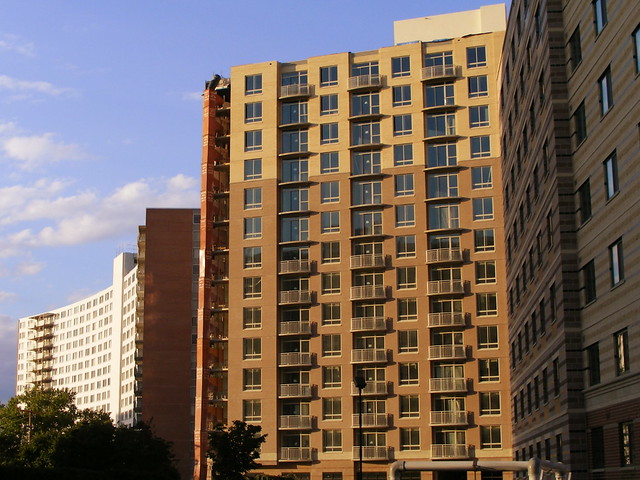 |
| Old and new apartments in South Silver Spring, shown in 2009. All images by the author. |
Economists say one of the best ways to provide more affordable housing is through filtering, a theory that as expensive new homes age and decline in value, they'll become low-cost homes tomorrow. But this requires building enough housing to keep up with demand. Is that possible?
600 new apartments and condominiums were built in downtown Silver Spring last year, while another 1,300 apartments are under construction as we speak. Almost all of them are high-end, luxury rentals.
While there are more affordable alternatives to be found, the area as a whole has become more expensive in the past ten years. Persistently low vacancy rates suggest there's a lot of demand for housing as well, further pushing up rents.
I looked at 32 market-rate (as opposed to entirely subsidized) apartment complexes within a mile of the Silver Spring Metro station, which includes downtown Silver Spring, South Silver Spring and East Silver Spring. I found their advertised monthly rents and unit sizes on the landlords' websites and sites like apartments.com, apartmentguide.com and rent.com, and used everything from Historic Silver Spring to aerial photos from the 1950's to find out when each building was built.
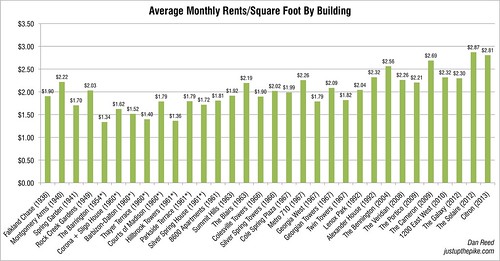 |
| Click image to see a larger version. |
Rents varied dramatically across the 32 complexes, and as predicted, age appeared to be a factor. Apartments at the Solaire on Ripley Street, which opened last year, rent for an average of $2.87 per square foot, more than twice the $1.36 rent per square foot at Hillbrook Towers on Thayer Avenue, built in 1961. Typical 2-bedroom units at both buildings rent for $3,023 and $1,250 a month, respectively.
It's said your annual income should be 40 times the monthly rent for an apartment to be truly affordable. Thus, you'd have to make $120,000 a year to live at the Solaire, or $50,000 to live at Hillbrook Towers.
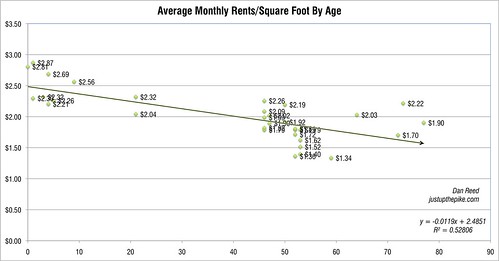 |
| Click image to see a larger version. |
Next, I plotted each building's age and its average rent per square foot and found a trendline. As it turned out, each year since a building was built takes off about 1.19 cents in monthly rent per square foot, or $11.90 for a 1,000-square-foot 2-bedroom apartment. That may not seem like much, but over time, it adds up to a $595 difference between a unit built this year and one built in the 1960's.
According to the 2007-2011 American Community Survey, 25% of the apartments in and around downtown Silver Spring were built during the 1960's, and another 33% before that. This period was the first big apartment boom in Silver Spring, with even more units constructed than during the 2000's. Shouldn't this mean that there are lots of cheap apartments like at Hillbrook Towers? Not quite.
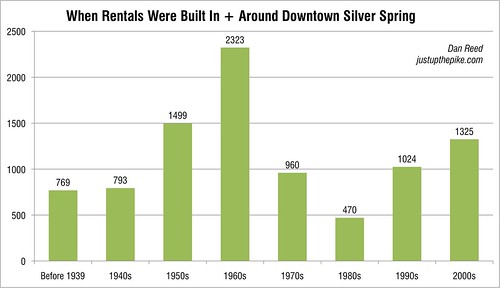 |
| Click image to see a larger version. |
Low vacancy rates in and around downtown suggests that the market is absorbing any new apartments that get built. According to the 2000 Census, just 2.5% of the then-8200 apartments in the area were vacant. In 2009, that rate had doubled as several new buildings opened. By 2011, with 9100 apartments in the area, the vacancy rate fell back to 3.35%. In Census Tract 7025, which contains several recently-built apartment buildings in downtown and South Silver Spring, just 1.67% of all apartments were vacant in 2011.
For filtering to work, there have to be enough new apartments to soak up the demand for new housing. Without it, landlords will upgrade their older buildings to draw those potential tenants.
That's what happened at the Blairs, the massive 1960's-era apartment complex across from the Silver Spring Metro station, whose owners recently completed a major LEED-certified renovation. While it's made the complex more environmentally sustainable, it's also resulted in higher rents. A renovated 2-bedroom apartment was recently advertised on their website with rent of $3060 a month, comparable to new construction.
A combination of new, high-end buildings and old buildings that are essentially being made new means that rents overall continue to rise. In fact, rents in and around downtown Silver Spring have increased by 75% since 2000, 3 times faster than inflation.
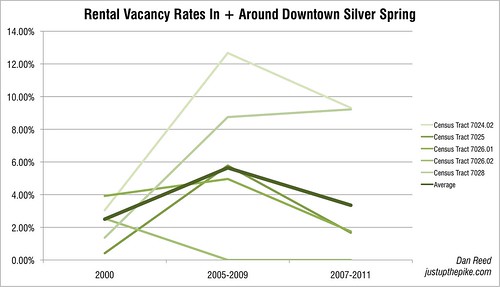 |
| Click image to see a larger version. |
In 2000, the median rent for all apartments in the area was $808 a month, which would be $1042 today. In 2011, it was $1410 a month, which suggests that apartments like the one at Hillbrook Towers are the exception, not the rule.
It's true that downtown Silver Spring has grown a lot in recent years, so much so that some residents say they've had enough. But the area isn't even growing as fast as did a half-century ago, and even after a global economic recession, the demand to live here remains strong.
Silver Spring prides itself on its diversity, but that's threatened by rising rents. Filtering isn't the only tool we have to protect affordable housing, but it's one we should take advantage of.

8 comments:
Very useful article Dan. More journalism, less preaching. I like it.
If we want more affordable housing in the DTSS area, we need more housing stock. It's unfortunate that some people would rather put their own small considerations above the needs of other people and society as a whole, but that is what has happened in some areas of Silver Spring. Converting a one-story self storage site into a building that could support several hundred residents is exactly the kind of thing that Silver Spring needs to do to be able to support more residents and ease the housing issues we have.
The idea that Silver Spring is overbuilt is foolish and shortsighted. The population of the US is still surging, and DC in particular is booming. The high rents are proof of a tight market, as is the vanacy rate.
We need more housing stock of apartments, condos and townhouses to meet demand. Unfortunately, Montgomery County and some of its residents are lagging behind the needs of people and the market. The market in DC and NoVa is booming again, but we just haven't brought enough new stock online for MoCo to enjoy some of what NoVa and DC are enjoying right now. Our outdated zoning has also held MoCo back, and our county is aging because it's less appealing than other jurisdictions for the next generations.
New apartment complexs help make older complexs cheaper. These complexs will allow DTSS to support more middle income and lower people. When I first lived in the area, I lived in an old building. It didn't have the fanciest features in the world, but it worked, and it allowed me to live in this area. I could not have afforded to live in most of the new buildings, but the new buildings help making older buildings more affordable.
Now I'm a bit older and farther along in my career, and was able to purchase a condo. But without more housing stock coming online, it will be harder for some people to live in this area. At a mimimum, we have to keep up with population growth in the DC region, but we really need more housing stock than that to help make this area more affordable. It's also good for the environment, traffic and human health to build more housing new transit stations than upcounty.
The answer is not more MPDUs. That's a market distortation that drives up pricing for middle class residents. If you make a few thousand more than the top-end of the MPDU range, it's very difficult to live around here. The answer is more housing stock, which will benefit all income ranges. I'm not against MPDUs, but a big push for them without a push for more housing will not help many middle income residents, and could in fact hurt there ability to live around here.
You've also pushed for accessory dwellings, and ideas like that will also help this area support a more diverse population. I am curious to why some people and some of our elected officials don't see the need for more housing and more housing types. Perhaps it is because our council members don't really understand urban areas.
Hate to bring cold water on the situation. But regional economists are predicting that the Washington, DC regional economy is heading for a decline and then long-term stagnation. The federal government has to slice hundreds of billions of dollars from agencies and programs over the next decade. The current budget deficit situation is simply unsustainable and there's no question that the Washington, DC region has profited from years of federal overspending. The new job growth numbers and wage/salary increases have far exceeded the national averages.
What does this mean for the Silver Spring rental market? For starters, I would bet many Silver Spring residents are tied to the federal government either through full-time employment or as a contractor. Some work for non-profit organizations that are dependent on federal grants for projects. If the spigot turns off then projects and jobs disappear in a hurry.
In the next few years, I expect most current residents of downtown Silver Spring to have lower income gains and in the worst case scenario, job loss and a smaller paycheck with the next job opportunity.
The 2013-2020 time span will be an interesting time for real estate management companies and their tenants. In the face of declining incomes and a declining population, can the property management companies justify significant rent hikes in the next few years? Can the real estate developers justify well-above-the-median rental costs for new apartment buildings?
The Go-Go Boom days of excessive budgeting for the Pentagon, Homeland Security, and the National Institutes of Health are coming to an end. It was fine to raise monthly rents by 10 or 20 percent on tenants OR offer $1,800 for brand new studio apartments because the government spending engine created new jobs and big income raises for workers from the years 2000-2012. I don't think the monster rent increases or the outrageous starting rental prices with new MDU projects pay dividends anymore. The real estate companies should be careful here. Silver Spring might have already hit its economic growth peak and it could be a rough, downhill crash soon.
I think there's zero doubt inside the beltway will be just fine, Craig. Demand will be high for places like DTSS for the foreseeable future, with our without fed growth.
I think filtering happens more at a regional than neighborhood level. At least in the medium term I think there is a virtuous cycle that more luxury buildings leads to the types of buildings that attract more high end residents. In the long-term filtering has to occur at least at a regional level unless the market was somehow overwhelmed by a glut of new housing. Nonetheless, new DC area residents are going to go somewhere and I think it better that they go to an established urban area like Silver Spring than the outer burbs. I agree with your assertion that Silver Spring needs more housing (and I can't stand the grousing against it in my neighborhood association and list serve).
On another note, this is an amazing next level article and I want to start an urban development consultancy or run for county executive just to hire you Dan. Keep up the good work.
Thanks for doing all this data collection and analysis -- it is really fascinating and will be useful to reference back to as time goes on.
I don't think everything will be fine in the long term.
Why did the Silver Spring real estate market take off from the year 2000 and onward?
1. Building the Discovery Channel HQ.
2. The huge jobs boom created by federal government spending attracted migrant professionals to the DC area in record numbers during the past decade.
3. The commercial redevelopment project on Ellsworth Street.
Out of the three reasons, I would peg reason #2 as the main engine of property value inflation and rent increases in downtown Silver Spring. The demand for housing reached sky-high levels during the 2000s decade and the developers could barely keep up with new condo and apartment projects.
The landlords and developers are betting that the Boom Times will continue for years to come.
Problem though. The downtown Silver Spring rental market has reached a point where only high-income professionals can afford apartment living. As a result, a big chunk of the working population has been EXCLUDED from entering into buying or renting in downtown Silver Spring.
The problem is that the DC region has a limited supply of single professional attorneys, IT engineers, architects, physicians, entrepreneurs and higher GS income Fed Gov. employees. Single professionals making $75,000-$200,000 per year have choices where to live in the DC region.
Arlington, VA
Bethesda, MD
Several established and gentrifying neighborhoods in The District
In other words, Silver Spring has competition for a small yet prized demographic sector of the population. And I can tell you that Silver Spring does not stack up well against Arlington, VA or several NW DC neighborhoods in terms of amenities and lifestyle choices for semi-affluent professionals.
If you work for Discovery Corp. or if you have an office job in Bethesda then paying $2,100 per month for a one-bedroom apartment makes sense. But if you are looking for a neighborhood that has a vibrant dining, bar and club culture, you ain't gonna find it in Silver Spring. If you are looking for hip and stylish clothing and furniture stores with serious price tags, you ain't gonna find it in Silver Spring. If you are concerned about personal safety then you might feel better living in a Ward 3 neighborhood in DC than Silver Spring.
We are reaching a point where the market rents in downtown Silver Spring do not reflect reality. By excluding 90 percent of the working population, the landlords and developers are pricing lots for the professional elite 10 percent. Catering to the top 10 percent is a risky game for the property owners.
I hope this will come back to bite the landlords in the ass some day.
Craig, "We are reaching a point where the market rents in downtown Silver Spring do not reflect reality. By excluding 90 percent of the working population, the landlords and developers are pricing lots for the professional elite 10 percent." just isn't anywhere near reality. You're putting way too much weight in the outlier (Solaire, with their very high-end building in arguably the best parcel DTSS has to offer) as opposed to the bulk of DTSS multi-family housing.
DTSS isn't cheap and it isn't going to be getting any cheaper, but as far as inside the beltway goes, it's still has a large number of relatively affordable units. You're complaints would be much better suited for NoMa or a similar neighborhood where everything is new and everything is "luxury".
Post a Comment